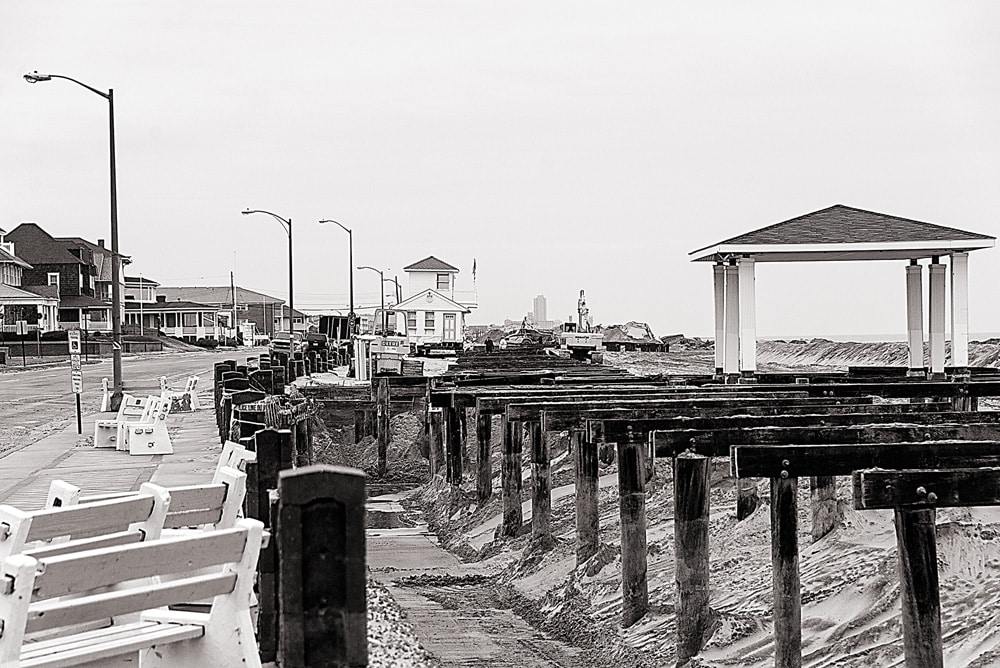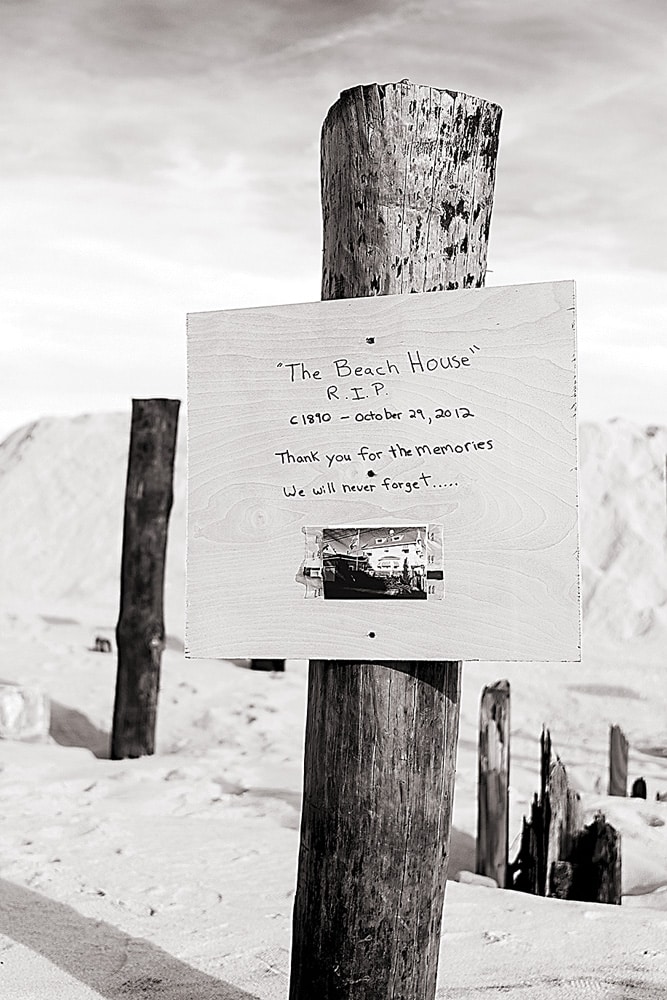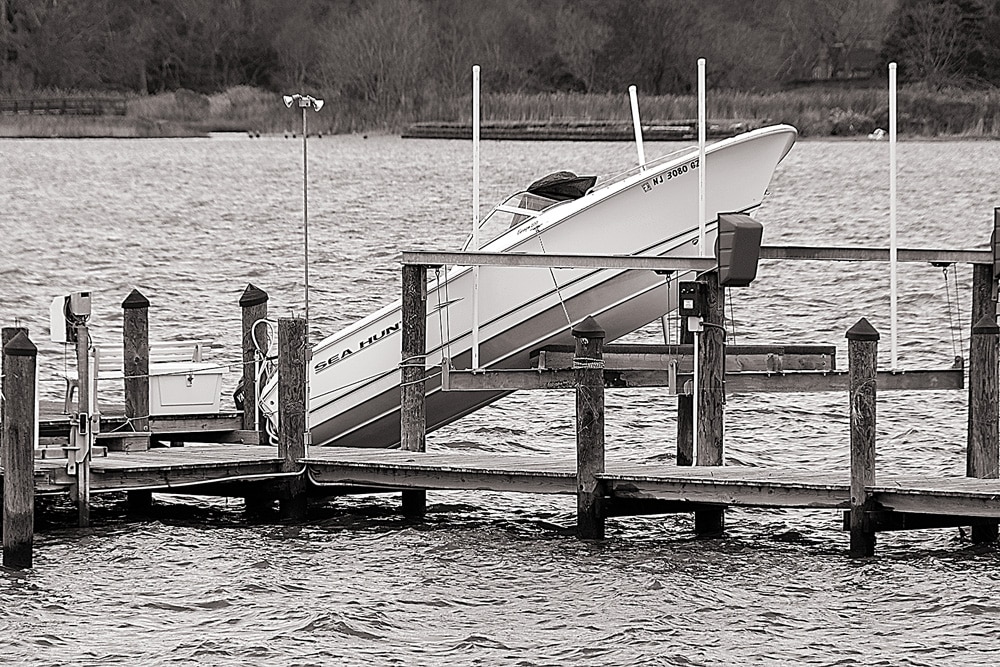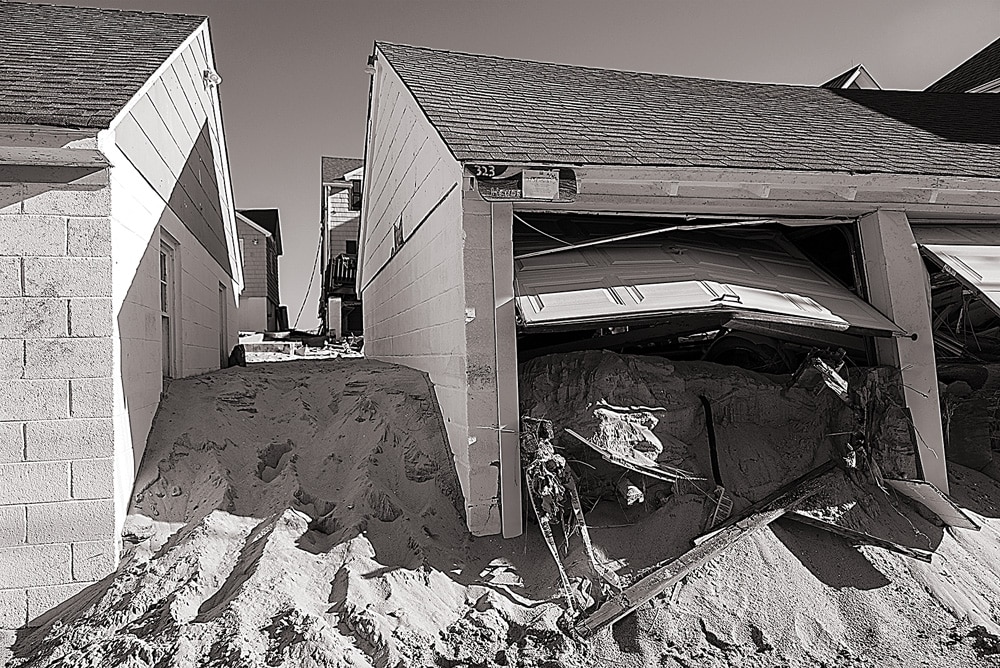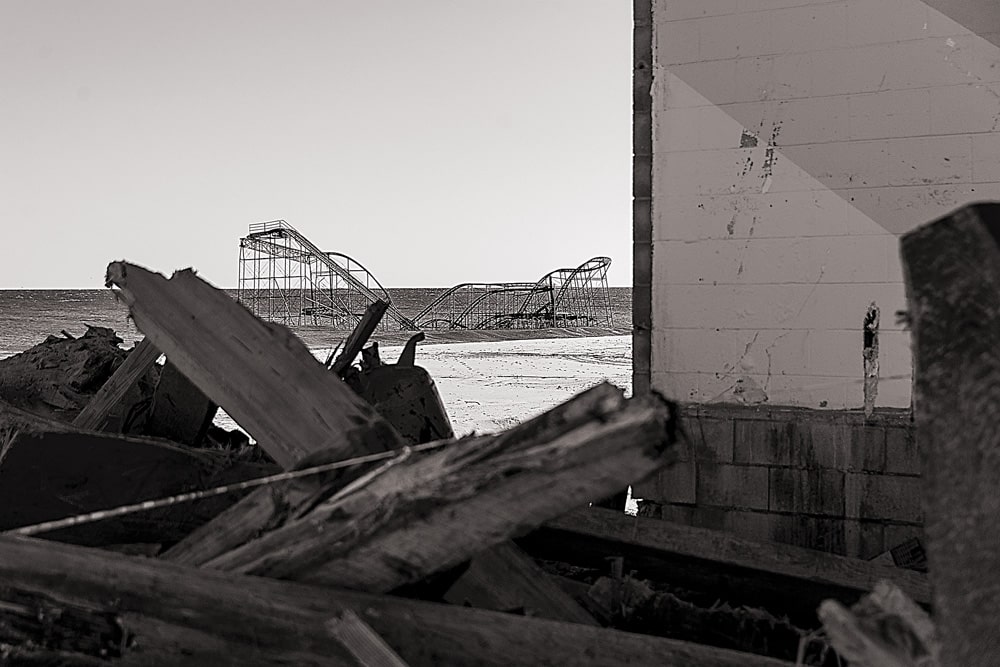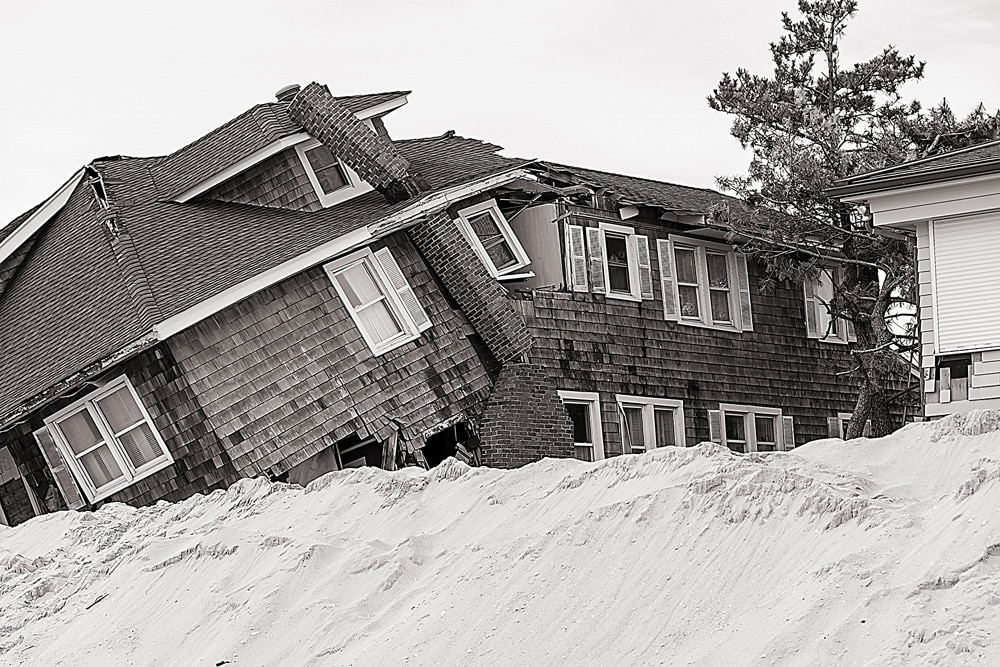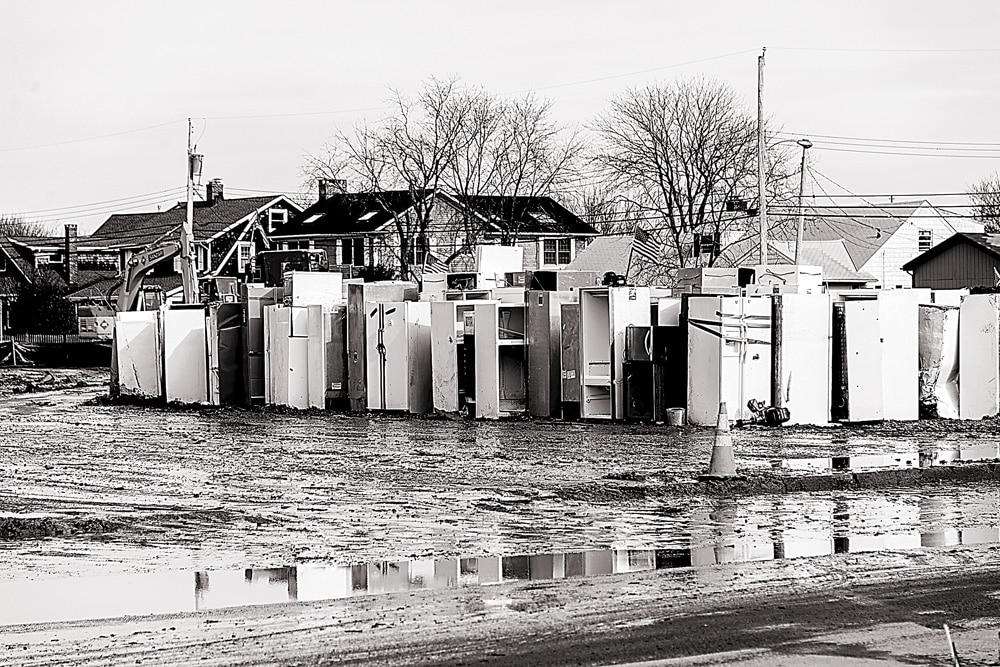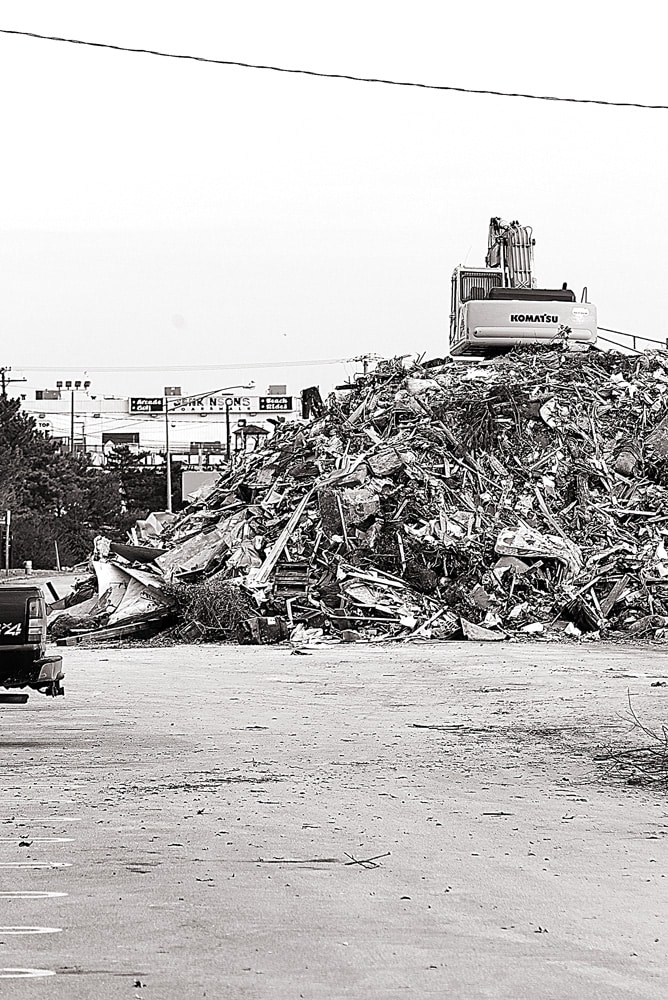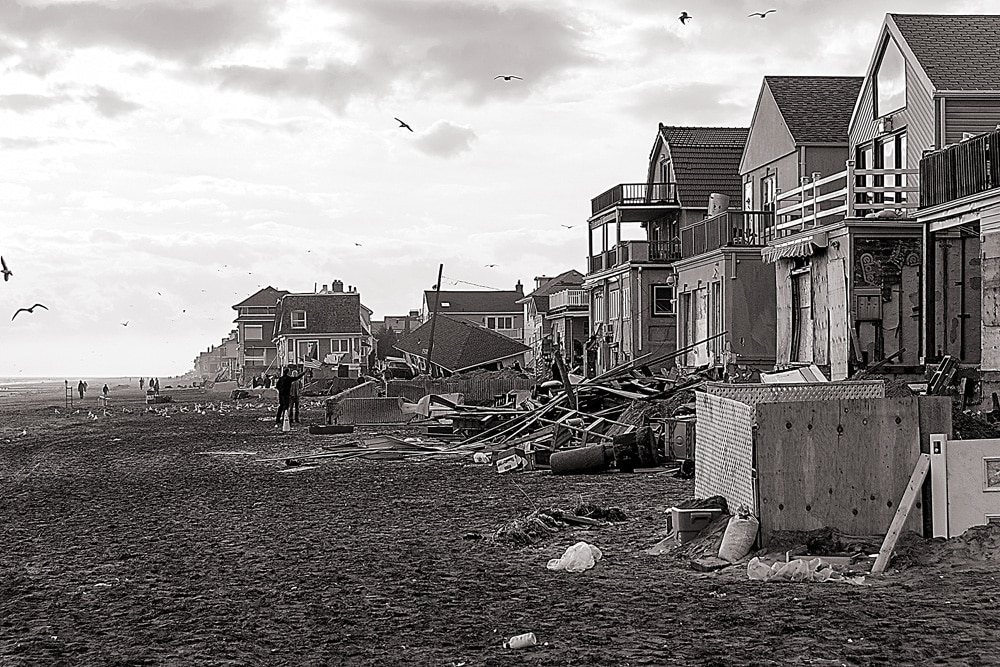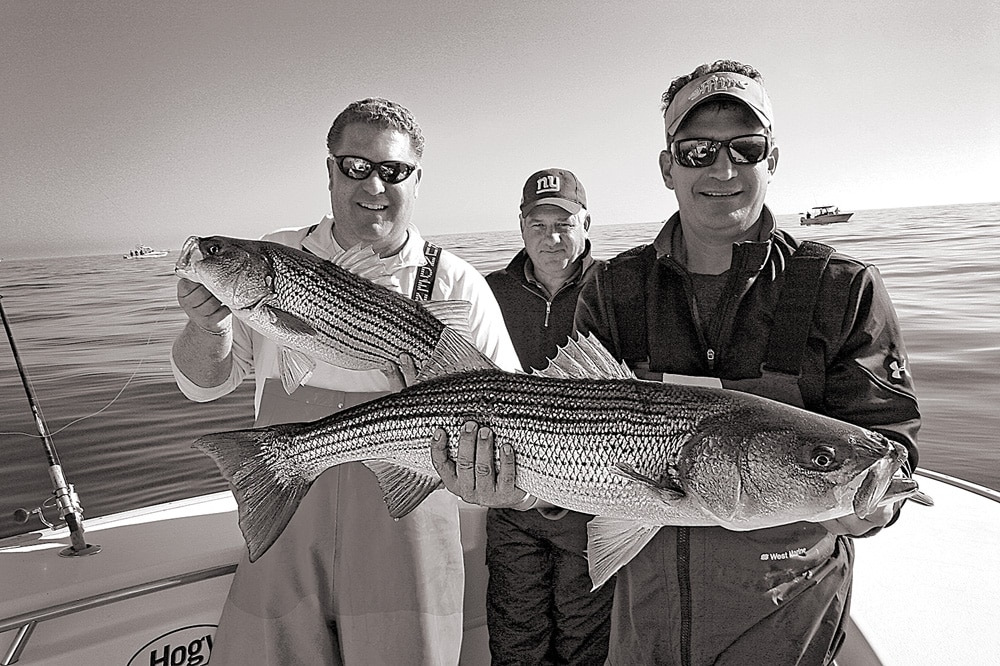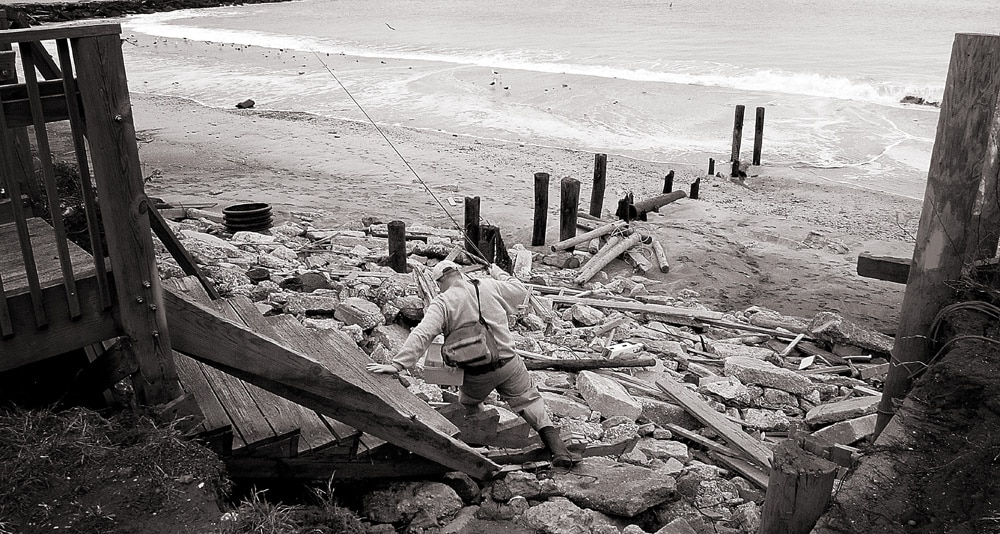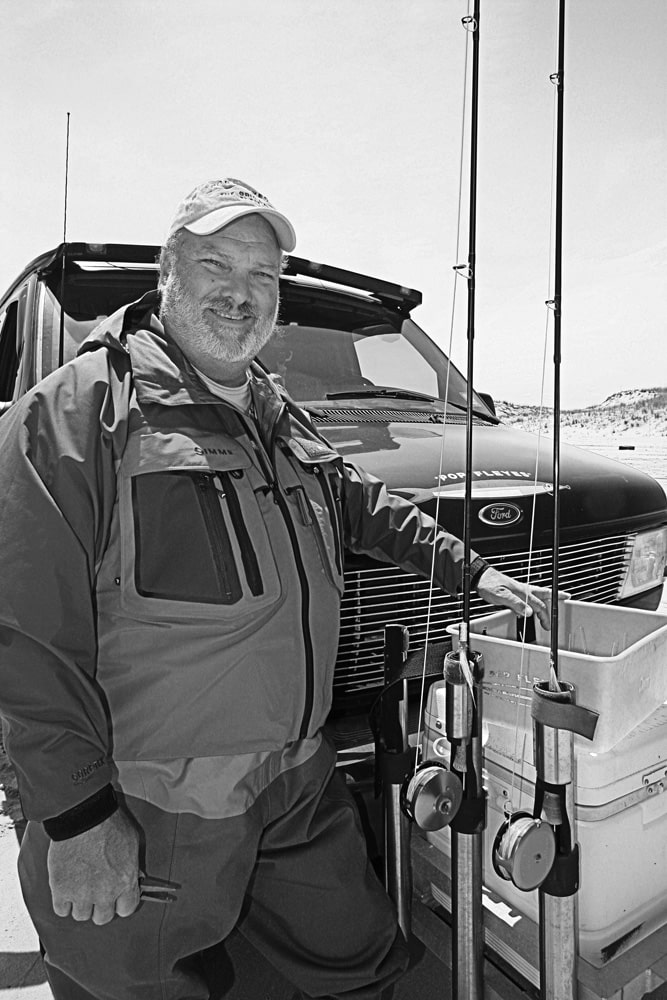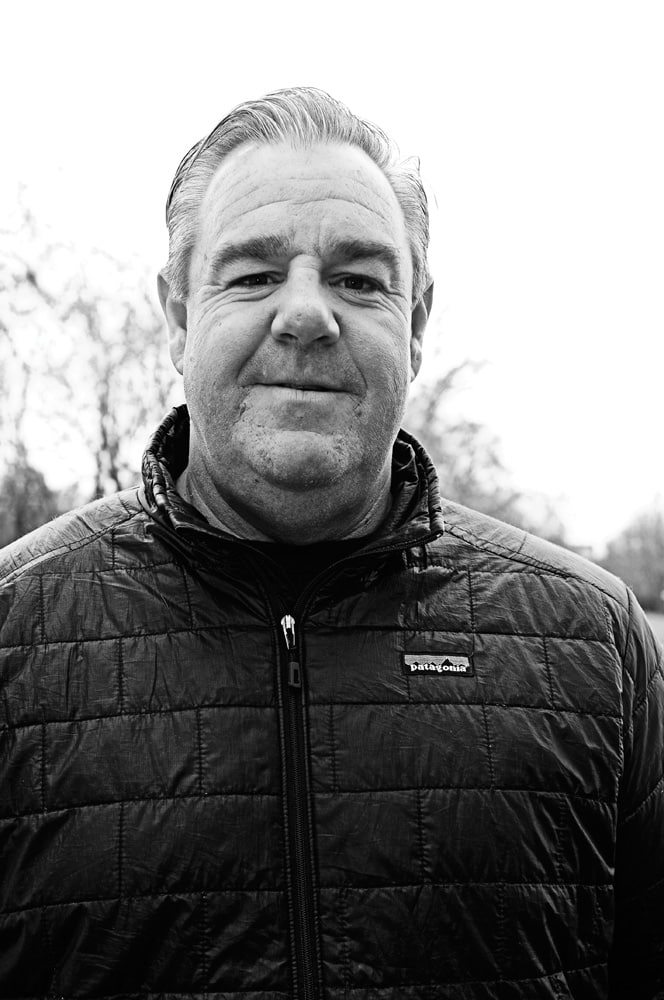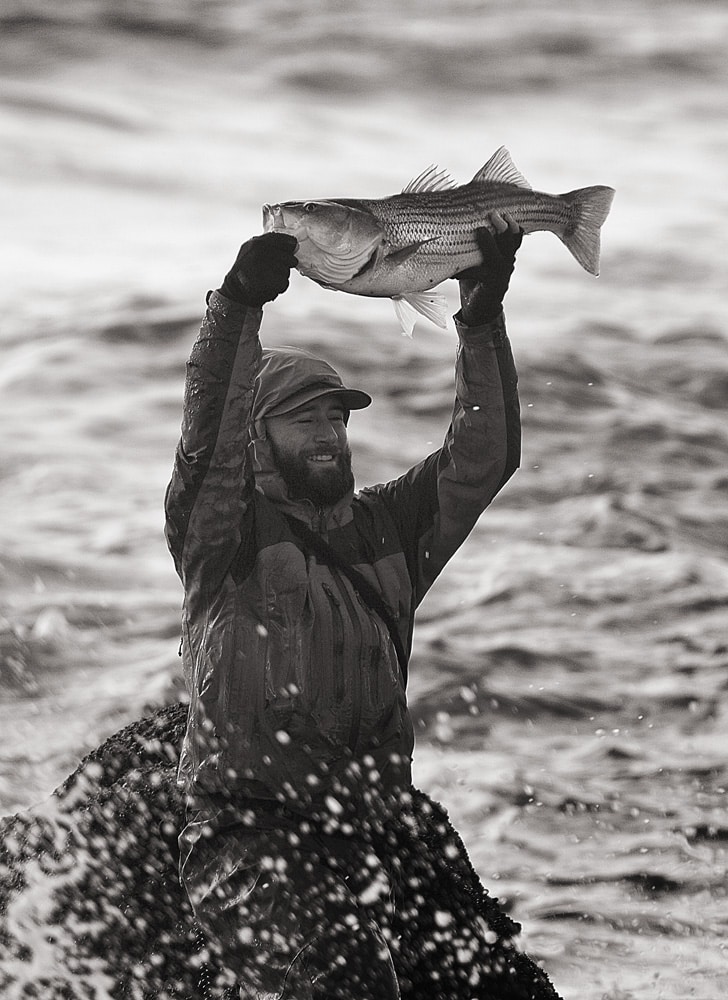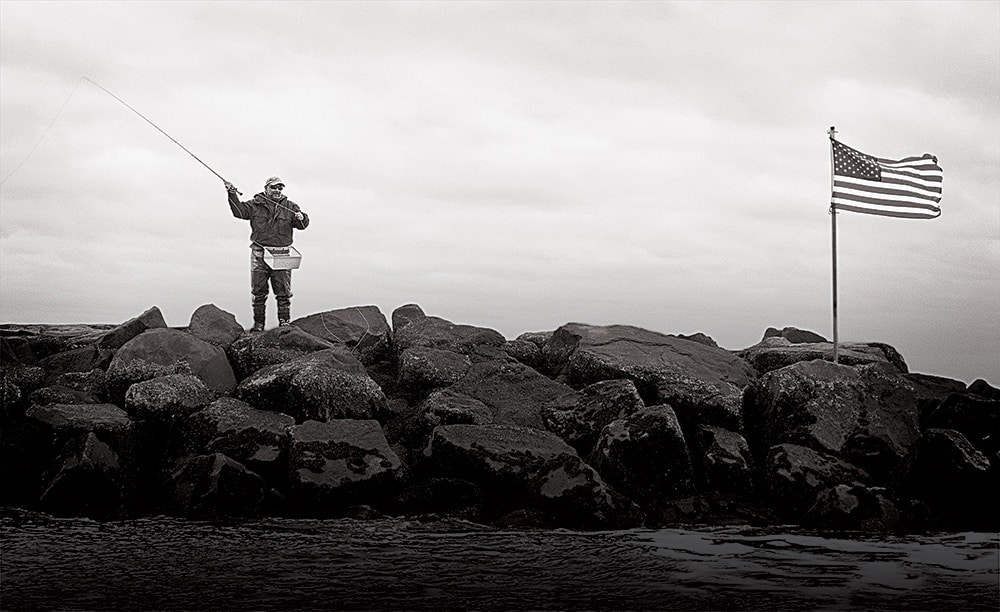
Be sure to click through the images in the gallery above.
Autumn was in the air and the New Jersey coastal beaches were starting to get into full swing with blitzlike conditions. It had been a good summer; the backwaters were full of baitfish that would set the shore up for a fine fall run of stripers and bluefish. As the air chilled and nights began to frost, you could feel the excitement up and down the beaches as fly-anglers prepared for the action that would soon come — the famous fall migration.
I was in the midst of getting my boat ready for the long-awaited season. For me, the fall season could not have come quicker. As much as I love running 30 to 50 miles offshore on blue-water trips, the long rides and lack of sleep had caught up with me, and it was time to switch gears and chase fish boiling the waters closer to home. During a hectic day of changing out all of my offshore tackle for inshore gear, the first word of Hurricane Sandy came across my Raymarine E140 with a Sirius satellite warning. Hmmm, I thought to myself. Seemed a little late for a hurricane. Halloween was right around the corner, and although technically we were still in hurricane season, it was far later than I could ever remember seeing one on our coast.
Mixed with emotion, I sat and pondered what it meant for me personally. As a fishing guide, this meant more canceled trips and potentially an end to the fall fishing season that had just started. Surely we have seen many hurricanes come up our coast and veer east or make landfall to the south. But a direct hit in the New York metropolitan area could end a season that never even started. Because I surf, an uncontrollable excitement came over me. This meant waves — really big waves.
It’s difficult to be a surfer in New Jersey — it’s really kind of a love-hate relationship. Summers are filled with long flat spells or small mushy waves, while the fall brings low-pressure systems and hurricane swells that rival surf anywhere in the world. Like a kid at Christmas, I almost welcomed the storm. Most likely it would roll past us offshore a few hundred miles, giving us great waves and little threat of any coastal damage.
Word of a direct hit to our area spread quickly. While many local residents and businesses began to prepare for what could potentially be a very destructive weather system, most went about daily life as they normally would. See, in the fall of 2011, Hurricane Irene hit the Jersey coast dead on. Irene, a Category 1 hurricane, made landfall in August 2001 in North Carolina and again in southern New Jersey and, for the most part, was a dud. Sure, there was damage and a bit of flooding, but nothing like the punch of a traditional hurricane.
It wasn’t until the days leading up to the storm that the impending doom of Sandy truly hit home. This was not an ordinary hurricane, or ordinary circumstances. Sandy was five times the size of Irene and was one of the largest hurricanes to hit the United States. With sustained winds of 90 to 110 miles per hour, this immense storm was not to be taken lightly. Sandy packed a deadly low pressure of 940 millibars and is on record as being the second most costly hurricane in U.S. history. If that wasn’t enough, what made Sandy unique were the circumstances around the timing of its landfall. As the Oct. 28 date closed in, it appeared that Sandy would make landfall at night, on a full moon and during a high tide — creating coastal surges upwards of 13 feet above normal, with enough power to destroy everything in its path. With time running out, residents began to prepare. People prepped their homes for impact, pulled and secured boats, and bought generators, batteries, fuel, food and water.
In the midst of everything, the storm caused the pressure to drop and the fishing turned on. Just a few days before Sandy’s landfall, I experienced one of the best fly-fishing charters of the season as acres of bass and blues blitzed on small baitfish up and down the coast from Sandy Hook to Manasquan. If there is one thing I have learned about fly-fishing for striped bass over the years, it’s that there are two instances when they feed frivolously during the daytime. First is during the last three to four days leading up to the full moon, and second is right before a storm when pressure is dropping. Coincidentally, both of these instances were taking place just days before Sandy hit New Jersey.
While about 85 percent of the boat owners in our area opted to pull their vessels out of the water, a select few, including myself and my partner, Jim Freda, decided to ride it out in the water on floating docks.
In the last 24 to 36 hours leading up to the storm, both New Jersey Gov. Chris Christie and New York Gov. Andrew Cuomo began issuing states of emergency and mandatory evacuations along coastal communities. Only about three-quarters of a mile from the westernmost portion of the mandatory evacuations, my area was under a voluntary evacuation. The captain in me ultimately led me to the decision to not evacuate. Instead, I’d stay and experience firsthand just how powerful Sandy was. Having weighed the risks, I felt pretty good about my safety and began to quickly load up on supplies like batteries, ice, nonperishable food, candles and other ancillary items to get me through a bad storm. What I hadn’t prepared for, however, was 11 days without power or fuel and unseasonably cold nights.
At 1 p.m. Oct. 29, power along the Jersey shore was nonexistent. Sandy was near, and the impending doom darkened quickly over the community. I felt a dying need and desire to visually see the ocean. With Sandy still off to the southeast, the ocean looked more ferocious than I had ever seen it in my life. Twenty-foot waves rolled offshore covering jetties and pounding the shoreline. It seemed as though every wave brought the surge closer and closer to the boardwalk where I stood. I then realized it: We were on our own.
To add fuel to the fire, the storm hit at night. Full moon, high tide and in the dark. As my family tried to sleep, I stayed awake, wondering all the while if my home would make it. Trees were being ripped out of the ground; telephone poles and wires were falling like they were being chopped down on purpose. Transmitters up and down the street were exploding like bombs being dropped from the sky. Thoughts raced through my head. What was happening to the oceanfront? All of those homes must be getting destroyed. How about the local businesses, tackle shops, marinas? What about my boat? Was it still floating? That night was the longest of my life. Late the next morning when it was all said and done, I set out to assess the damage.
The morning after was truly a wake-up call. The damage was massive. Boats were strewn up and down the streets, houses ripped from their foundations, trees and telephone poles down. There was no power and no cell phone service. Somehow, I was able to get off a few texts here and there, but for the most part we were on a deserted island. I recall receiving a text from my good friend Bob Popovics, who had taken refuge in his family restaurant, the Shady Rest. Bob lives right at the mouth of Island Beach State Park in the borough of Seaside Park. Seaside saw some of the, if not the, worst destruction on the shore, and Bob’s house was considerably damaged.
Out on Long Island, Capt. John McMurray, who had weeks before moved into his waterfront home along the bay, sent word that his entire first floor had flooded. Local businesses, tackle shops, charter boats and residents were uprooted. The lucky ones lost power for longer than a week, while the ones that were not so lucky saw damage to their homes and businesses on all different levels of severity. Sandy was not in any way selective. It was not just the “money” mansions on the beach that were destroyed. Many oceanfront communities on the barrier island of Ocean County lost homes that they had built and lived in for 30 to 40 years. These people lost more than material items — they lost a way of life. As the days went on after Sandy’s visit, things seemed to resonate. The National Guard stormed the beaches creating a feeling of Red Dawn, for those of you who saw the movie. Many areas were off-limits, and even the people who resided in those communities were not allowed back in for weeks on end.
There was one thing, however, that was consistent from the south shores of Long Island all the way to the southern beaches of New Jersey — the strength and hope displayed by the people. So what is the silver lining in all of this? There was one thing Sandy could never take away from us, and that was our can-do attitude — a Jersey type of “we won’t be defeated” culture that can never be broken. Despite all of the damage and uncertainty, the people of New Jersey and New York immediately pulled together to start restoring their communities. There were no riots, no looting and no crimes. Rather, people stopped what they were doing despite how affected their lives had become to help someone else who was hurt more than they were. It was not just people from New Jersey who lent a helping hand. Electric companies from states including Ohio, Michigan and Arkansas drove their trucks out to get power back up. Police and fire companies from this country’s Midwest, Southeast and Northeast regions came to our aid, as did many large corporations and nonprofit outdoor and environmental groups. One group in particular, Waves for Water (wavesforwater.org), immediately launched shelters that were led by local surfers and fishermen and began a massive hurricane relief campaign to get supplies directly to the residents living in areas that were highly affected by the storm. Ramsey Outdoor Stores worked with outdoor clothing companies like Patagonia, The North Face and Columbia to get warm and waterproof outdoor clothing to those in need. The mood quickly changed, and the devastated community quickly emerged as a unified culture dedicated to restoring the areas. Make no mistake: It will take millions of dollars and several years to rebuild the $65.6 billion of damage Sandy left in its wake.
I could not help but think about the fishery and what a storm of this magnitude meant to the rest of the fall run. The ocean had been uprooted like nothing I had ever seen. The day after the storm, the winds calmed and the waves were pumping. With the Coast Guard still not allowing boats on the coastal waterways, I decided to take a break and go for a quick surf to clear my head of everything that had happened. As I sat out in the lineup and looked toward the horizon, I saw a familiar disturbance, almost like sand eels skipping across the surface. “Couldn’t be,” I said to myself out loud. Paddling back out after a wave, out of the corner of my eye I saw a swoosh and then heard a pop. I stopped, and within seconds I saw that oh-so-familiar tail slap the water. Then, right before my eyes the stripers came up and put on a feeding show for me and me alone right there in the lineup. I knew then that our stripers are just as “Jersey strong” as the individuals that make up our community. Perhaps the season would be salvaged after all. Surely the economy could use it now more than ever.
Four days after the storm, the Coast Guard lifted the watercraft ban and started letting boats go out of the inlet. Because my boat survived, I invited out longtime friend and client Jim Ardito. Jim has fly-fished with me for years, and if there were anyone whom I felt good about taking out for a search mission, it was him. He understood the game and knew there were no guarantees. As we made our way up the coast, we saw large gannets high in the air circling, a good sign. We traveled farther up the line until we came across football fields of birds slamming the water. A few strips of line off the reel and a 30-foot cast and Jim was tight. For the next few hours we caught plenty of fish and enjoyed the ocean as if the storm had never existed. After a long day we decided to pack it in, and on the ride home I pulled the boat in close to the beach to get a better assessment of the damage. Once again I was reminded of the carnage. Our escape with the fish was simply that: an escape for only a few hours. However, as I swept my boat past the broken-down homes and boardwalk that I grew up on, I knew that deep down everything would eventually come back to normalcy. As long as it might take and as costly as it might be, there is one thing that stands out around Jersey, and that’s the never-give-up mentality of its people.
In the days immediately following the storm, I have spent a great deal of time talking with many guides, charter captains and tackle shop owners, all of whom will see a personal and financial impact due to Sandy. What was amazing was their attitude. “We will rebuild our shops, we will fix our boats, and we will be back in business before the bass leave for the winter.” Why? Because together we are strong, Jersey Strong.

